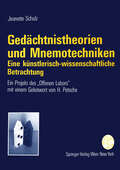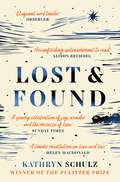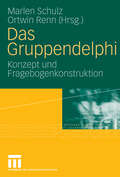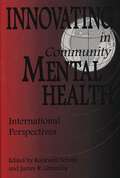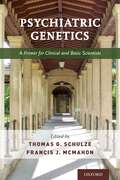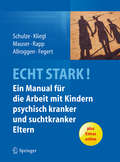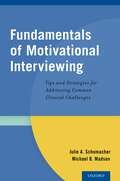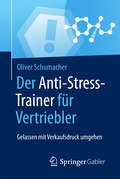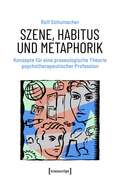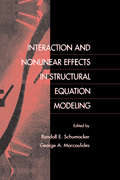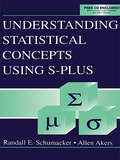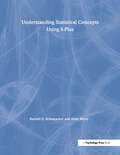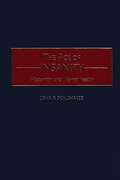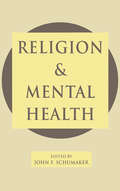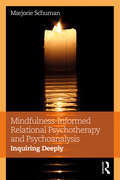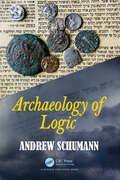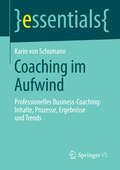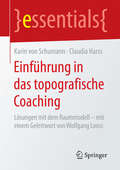- Table View
- List View
Gedächtnistheorien und Mnemotechniken: Eine künstlerisch-wissenschaftliche Betrachtung
by Jeanette SchulzDie geistige Schöpferkraft und das Gedächtnis sind unverzichtbare Vorbedingungen für das Wissen und die Kulturen der Welt. Während die Antike und das Mittelalter die große Bedeutung beider Faktoren noch klar anerkannte, wurde die Wichtigkeit des Gedächtnisses und seiner Schulung später immer weniger beachtet. Die Autorin - Künstlerin und Neurowissenschaftlerin - beschäftigte sich eingehend mit den Gedächtnistheorien und Mnemotechniken seit der Antike. Vor diesem Hintergrund entstand ein Werk, das weniger als Lehrbuch gedacht ist, sondern einen kurzen, amüsant bebilderten Streifzug durch die Ansichten der letzten zweieinhalb Jahrtausende bietet. Die humorvollen und häufig bizarren Bilder zeugen nicht nur von überschäumender Phantasie und Kreativität, sondern unterstreichen auch, wie wichtig es ist, für Gedächtnisstützen möglichst irreale Gebilde heranzuziehen.
Lost & Found: A Memoir
by Kathryn Schulz'An extraordinary gift of a book, a tender, searching meditation on love and loss and what it means to be human. I wept at it, laughed with it, was entirely fascinated by it. I emerged feeling a little as if the world around me had been made anew.' – Helen Macdonald, author of H Is for Hawk and Vesper FlightsEighteen months before Kathryn Schulz’s beloved father died, she met the woman she would marry. In Lost & Found, she weaves the stories of those relationships into a brilliant exploration of how all our lives are shaped by loss and discovery - from the maddening disappearance of everyday objects to the sweeping devastations of war, pandemic, and natural disaster; from finding new planets to falling in love.Three very different American families form the heart of Lost & Found: the one that made Schulz’s father, a charming, brilliant, absentminded Jewish refugee; the one that made her partner, an equally brilliant farmer’s daughter and devout Christian; and the one she herself makes through marriage. But Schulz is also attentive to other, more universal kinds of conjunction: how private happiness can coexist with global catastrophe, how we get irritated with those we adore, how love and loss are themselves unavoidably inseparable. The resulting book is part memoir, part guidebook to living in a world that is simultaneously full of wonder and joy and wretchedness and suffering - a world that always demands both our gratitude and our grief.A staff writer at the New Yorker and winner of the Pulitzer Prize, Kathryn Schulz writes with curiosity, tenderness, erudition, and wit about our finite yet infinitely complicated lives. Crafted with the emotional clarity of C. S. Lewis and the intellectual force of Susan Sontag, Lost & Found is an uncommon book about common experiences.
Das Gruppendelphi: Konzept und Fragebogenkonstruktion
by Marlen Schulz Ortwin RennDer Band widmet sich dem Gruppendelphi, einer diskursiven Methode, die häufig zur Entwicklung von politischen Leitbildern und Planungszielen eingesetzt wird. Anhand verschiedener Beispiele aus der Praxis wird die Methode des Gruppendelphis vorgestellt und kritisch reflektiert. Der inhaltliche Fokus liegt dabei auf dem Fragebogen, dem methodischen Herzstück eines Gruppendelphis. Zunächst wird das klassische Delphi-Verfahren vorgestellt und anschließend das Gruppendelphi als eine modifizierte Variante des Verfahrens eingeführt. Anhand dieser Methode wird die Fragebogenkonstruktion kritisch diskutiert. Untermauert werden die methodischen Vorschläge durch die Darstellung von fünf Praxisbeispielen, bei denen das Verfahren des Gruppendelphis angewendet wurde. Eine Software zur Auswertung eines Gruppendelphis findet sich auf der Homepage des Verlages.
Innovating in Community Mental Health: International Perspectives (Non-ser.)
by Rockwell Schulz James R. GreenleyInnovating in Community Mental Health presents lively examples of successful attempts to change mental health service systems in innovative ways to achieve the goal of providing care for persons with severe mental illness. These examples are drawn from such diverse national settings as Italy, Russia, Germany, England, China, and the United States, and involve a range of stratgies from treatment teams of professionals, grassroots community organizations, consumer cooperatives, professional-volunteer teamwork, and housing-based alternatives. The stories of these varied innovations are told by established, knowledgeable scholars from each of the featured countries. The editors help us understand the triumphs and pitfalls involved in these innovations through the presentation of a broad, research-based theory of innovation and change, which is used to guide the presentation of the examples and subsequently to determine their similarities and differences.Through the theoretical framework presented, the nuances of the process of innovation are highlighted, including the importance of the type of innovation itself, the wider environmental influences, place of internal organizational structures, and the role of the individual change agent. Through this framework and the examples presented, the reader is given indications of how innovation and change may be possible in such diverse and seemingly difficult situations, and also of how effective strategies for change might be chosen by administrators, providers, and other policymakers.
**Missing**: Einstellungen zu Migranten in Deutschland und Europa (Blickpunkt Gesellschaft)
by Sonja Schulz Pascal Siegers Bettina Westle Oshrat HochmanDieser Band versammelt verschiedene Untersuchungen zu Einstellungen zu Migranten und zu nationalistischem Wahlverhalten, die alle auf repräsentativen Bevölkerungsumfragen beruhen. Insgesamt verdeutlicht die Gesamtschau der in diesem Band versammelten Beiträge die Bedeutsamkeit von (positiven) Kontakten zwischen der deutschen Aufnahmegesellschaft und der Migrantenpopulation. Hinweise auf eine allgemeine Verschlechterung des Meinungsklimas gegenüber ethnischen Minderheiten ergeben sich aus den Studien nicht. Sofern Migration nicht als Bedrohung für den eigenen Status wahrgenommen wird, kann verstärkter Kontakt dazu führen, dass die deutsche Bevölkerung insgesamt toleranter und offener wird. Im Gegenschluss kann eine wahrgenommene Bedrohung des eigenen Status und der eigenen Ressourcen zu einer gesellschaftlichen Polarisierung führen. Der Wandel hin zu einer größeren Akzeptanz Zugewanderter ist also nicht irreversibel: Die „offene Gesellschaft“ in der Bundesrepublik muss ständig aktiv erarbeitet werden.
Fahren auf nächtlichen Straßen unterschiedlicher Helligkeit (Verkehrspsychologie)
by Christoph SchulzeDem nächtlichen Straßenverkehr kommt eine hohe Bedeutung zu, wobei die Sichtbedingungen und deren technische Unterstützung durch künstliche Beleuchtung zentral sind. Ein Großteil der wissenschaftlichen Diskussion in diesem Bereich beschäftigt sich mit der Sichtbarkeit von mehr oder weniger definierten Einzelobjekten, oft vor einem anlassbezogenen Hintergrund der Verkehrssicherheit. Die vorliegende Arbeit widmet sich dem weit seltener beforschten, unter Praxisgesichtspunkten jedoch höchst relevanten, regelmäßig stattfindenden nächtlichen Fahrverhalten und untersucht, welchen Einfluss das Helligkeitsniveau (nächtliche Fahrbahnleuchtdichte) darauf hat. Ausgehend von einer heterogenen Theorien- und empirische Befundlage beforschen drei Fahrsimulatorstudien unter lichttechnisch kontrollierten Bedingungen den Zusammenhang bei unbeeinflusster Fahrt (verschiedene Voraussichtweiten und fahrregulatorische Anforderungen) sowie bei Manövern im Fahrprozess, die Teil der permanenten Längs- und Querführung sind (Übergänge Gerade zu Kurve) oder eher singulären Charakter haben (Fahrstreifenwechsel). Im Ergebnis wird ein bedeutsamer Einfluss des nächtlichen Helligkeitsniveaus von Straßen auf das regelmäßige Fahren belegt und ein Beitrag zur Klärung der diesbezüglich heterogenen Literaturlage geleistet.
Psychiatric Genetics: A Primer for Clinical and Basic Scientists
by Md And Francis J. McMahon Thomas G. SchulzePsychiatrists and other mental health professionals are increasingly confronted with questions about the genetics of psychiatric illness, and the clinical applications of new genetic findings. Psychiatric Genetics: A Primer for Clinical and Basic Scientists addresses these questions through a straightforward introduction to the essentials of psychiatric genetics, complementing more comprehensive textbooks that may seem overwhelming for those new to the field. Written and edited by leaders in the field and the International Society of Psychiatric Genetics (ISPG), the book covers basic epidemiology, recruitment for human studies, phenotyping strategies, formal genetic and molecular genetic studies, statistical genetics, bioinformatics and genomics, pharmacogenetics, the most relevant animal models, and biobanking. Each chapter begins with a list of "take home" points that summarizes content, followed by a brief overview of current knowledge and suggestions for further reading. This Primer is ideal for medical students, psychiatric residents, psychiatrists, and basic neuroscience researchers who are interested in learning about the key concepts and recent advances in the exciting field of psychiatric genetics.
ECHT STARK! Ein Manual für die Arbeit mit Kindern psychisch kranker und suchtkranker Eltern
by Ulrike M.E. Schulze Katrin Kliegl Christine Mauser Marianne Rapp Marc Allroggen Jörg M. FegertDas vorliegende Manual dient als Leitfaden für die Durchführung eines ressourcen-orientierten Gruppenangebots für Kinder von psychisch kranken und/oder suchtkranken Eltern. Es wendet sich an professionelle Helfer, also Mitarbeiter in psychologischen Beratungsstellen bzw. Erziehungsberatungsstellen, kinder- und jugendpsychiatrischen Ambulanzen bzw. Einrichtungen der Suchthilfe oder Selbsthilfeeinrichtungen. Die einzelnen Module können ebenso im Rahmen der Jugendhilfe oder als Grundlage in der therapeutischen Angehörigenarbeit in psychiatrischen und psychosomatischen Fach- oder Rehabilitationskliniken eingesetzt werden. Neben wertvollen Hintergrundinformationen und Literaturhinweisen enthalten die einzelnen Module – schwerpunktmäßig und getrennt für Kinder- und Jugendlichengruppen – Schritt-für-Schritt-Anleitungen zur altersgerechten Vermittlung spezifischer Inhalte zu psychischen und Suchterkrankungen, eine Formulierung der mit den einzelnen Gruppenstunden verbundenen Ziele sowie Hausaufgaben für die Kinder zur weiteren Bearbeitung einer für sie lebensbestimmenden Thematik. Ein weiteres ausführliches Kapitel ist der Elternarbeit gewidmet. In dem vorliegenden Buch finden sich in handlungsorientierter Weise nicht nur konkrete Handlungsvogaben, ansprechende Materialien und wichtige Links, sondern auch erfahrungsgeleitete Anregungen und Tipps im Hinblick auf eine gelingende professionelle Netzwerkarbeit, sowie angemessene Gesprächsführung, einen sensiblen Umgang mit den betroffenen Familien, die Durchführung von Elternabenden, jedoch auch eine Auflistung möglicher „Stolpersteine“ in der Arbeit mit einer besonderen Zielgruppe.
Die leisen Stimmen der Vernunft: Tonaufnahmen im Schlachthaus der Geschichte
by Peter Schulz-HageleitGeschichte als Abfolge von Massentötungen aller Art und – im Gegensatz dazu – Geschichte als Konzert von leisen Stimmen, die den Frieden beschwören und Vernunft anmahnen: das sind zwei Leitmotive des Buches, die in verschiedenen Inhaltsvariationen thematisiert werden. Dabei finden die grauenhaften Tatsachen der Geschichte ebenso Berücksichtigung wie die kognitiv-emotionale Schwierigkeit, im historisch-politischen Schlachthaus-Geschehen (Kriege, Völkermorde) nicht die Augen zu verschließen, sondern vielmehr standzuhalten und existenziell für eine bessere Welt einzutreten.Was zur Zeit der ersten Auflage des Buches (2006) weit entfernt von realgeschichtlichen Möglichkeiten zu liegen schien, ein imperialistischer Eroberungskrieg, ist seit Februar 2022 bedrückende Wirklichkeit. Die veränderte weltpolitische Konstellation entwertet die früheren Reflexionen und Recherchen nicht, sondern taucht die Befunde in ein noch grelleres Licht.Das Buch wendet sich nicht nur an Personen, die Geschichte professionell erarbeiten und vermitteln, sondern an alle, die im Verhältnis zur Geschichte, wie es medienwirksam präsentiert und zelebriert wird, Probleme sehen.
Fundamentals of Motivational Interviewing: Tips and Strategies for Addressing Common Clinical Challenges
by Julie A. Schumacher Michael B. MadsonMotivational interviewing (MI) is an evidence-based communication style that has applicability to diverse professions ranging from mental and physical healthcare to criminal justice. Professionals use MI to help patients/clients harness their own internal motivations for change and become active partners in developing plans for change. Using MI, a professional can guide patients/clients to make positive changes in life areas such as substance abuse, criminal activity, anxiety and mood problems, poor cardiovascular health, and more. Fundamentals of Motivational Interviewing provides a straightforward, common-language, and user-friendly guide to key concepts in MI. The clinical challenges addressed are ubiquitous across helping professions, and this book is unique in its focus on providing practical guidance on what to do when confronted with each challenge. Based on the authors' years of experience providing training and supervision in MI, this book answers one of the questions most frequently asked by those they have trained: "How can I use MI to address [insert clinical challenge]?" Fundamentals of Motivational Interviewing is an accessible and easy-to-use resource organized and written with the busy provider in mind. It is appropriate for all skill levels ranging from the MI novice with no prior training, to the experienced MI provider seeking to gain new knowledge and skills. Throughout the book the authors use boxes and case examples to clearly illustrate and emphasize key points. The authors also provide clear examples of the sometimes subtle distinction between MI-consistent and MI-inconsistent use of the communication skills and strategies. Professionals from diverse disciplines including medicine, allied health, criminal justice, psychology, counseling, social work, marriage and family therapy, as well as MI trainers working with all of these disciplines will find this book a useful resource, and it would be an appropriate text for any class that seeks to build MI and other psychotherapeutic skills.
Der Anti-Stress-Trainer für Vertriebler: Gelassen mit Verkaufsdruck umgehen
by Oliver Schumacher Peter BuchenauDieses Buch aus der Anti-Stress-Trainer-Reihe beschäftigt sich umfassend mit dem Thema Stress bei Vertrieblern. Es dient als Ratgeber für alle Vertriebler, die unter Akquise- und Verkaufsdruck stehen, permanent auf der Straße unterwegs sind und/oder unter Zeitdruck und Dauerhochleistungen agieren. Konkrete und im Alltag anwendbare Anti-Stress-Tipps und Beispiele machen dieses Buch sehr praxisorientiert.
Szene, Habitus und Metaphorik: Konzepte für eine praxeologische Theorie psychotherapeutischer Profession
by Rolf SchumacherPsychotherapie ist jene Disziplin, die sich explizit mit den Bedingungen der Veränderbarkeit des Menschen befasst. Der Psychologische Psychotherapeut Rolf Schumacher gewährt neue Einblicke in die psychotherapeutische Praxis und fasst sie als professionelle Form sozialer, intersubjektiver Praxis — mit drei dokumentierten vollständigen Therapieverläufen als Fallbeispiele. Das Ziel dabei ist, ein integratives und eigenständiges Paradigma für die Psychotherapie auf erkenntnistheoretischer Grundlage zu begründen, das eine »praxeologische Theorie psychotherapeutischer Profession« und ein praxisorientiertes psychotherapeutisches Veränderungsmodell fördert. Dieser Ansatz ermöglicht auch eine Psychotherapiewissenschaft als (kritische) Disziplin der Humanwissenschaften, die natur-, sozial- und geisteswissenschaftliche Erkenntnisse integrieren kann.
Interaction and Nonlinear Effects in Structural Equation Modeling
by Randall E. SchumackerThis volume provides a comprehensive presentation of the various procedures currently available for testing interaction and nonlinear effects in structural equation modeling. By focusing on various software applications, the reader should quickly be able to incorporate one of the procedures into testing interaction or nonlinear effects in their own model. Although every attempt is made to keep mathematical details to a minimum, it is assumed that the reader has mastered the equivalent of a graduate-level multivariate statistics course which includes adequate coverage of structural equation modeling. This book will be of interest to researchers and practitioners in education and the social sciences.
Understanding Statistical Concepts Using S-plus
by Randall E. Schumacker Allen AkersWritten as a supplemental text for an introductory or intermediate statistics course, this book is organized along the lines of many popular statistics texts. The chapters provide a good conceptual understanding of basic statistics and include exercises that use S-PLUS simulation programs. Each chapter lists a set of objectives and a summary. The book offers a rich insight into how probability has shaped statistical procedures in the behavioral sciences, as well as a brief history behind the creation of various statistics. Computational skills are kept to a minimum by including S-PLUS programs that run the exercises in the chapters. Students are not required to master the writing of S-PLUS programs, but explanations of how the programs work and program output are included in each chapter. S-PLUS is an advanced statistical package that has an extensive library of functions, which offer flexibility in writing customized routines. The S-PLUS functions provide the capability of programming object and dialog windows, which are commonly used in Windows software applications. The S-PLUS program also contains pull-down menus for the statistical analysis of data. A ZIP file containing programs that work in S-PLUS 6.2 for use with this book is available for download from http://www.psypress.com/resources/9780805836233.zip - please note that these scripts will only run in S-PLUS 6.2 and not later versions due to changes in the programming language syntax.
Understanding Statistical Concepts Using S-plus
by Randall E. Schumacker Allen AkersWritten as a supplemental text for an introductory or intermediate statistics course, this book is organized along the lines of many popular statistics texts. The chapters provide a good conceptual understanding of basic statistics and include exercises that use S-PLUS simulation programs. Each chapter lists a set of objectives and a summary. The book offers a rich insight into how probability has shaped statistical procedures in the behavioral sciences, as well as a brief history behind the creation of various statistics. Computational skills are kept to a minimum by including S-PLUS programs that run the exercises in the chapters. Students are not required to master the writing of S-PLUS programs, but explanations of how the programs work and program output are included in each chapter. S-PLUS is an advanced statistical package that has an extensive library of functions, which offer flexibility in writing customized routines. The S-PLUS functions provide the capability of programming object and dialog windows, which are commonly used in Windows software applications. The S-PLUS program also contains pull-down menus for the statistical analysis of data. A ZIP file containing programs that work in S-PLUS 6.2 for use with this book is available for download from http://www.psypress.com/resources/9780805836233.zip - please note that these scripts will only run in S-PLUS 6.2 and not later versions due to changes in the programming language syntax.
Interaction and Nonlinear Effects in Structural Equation Modeling
by Randall E. Schumacker George A. MarcoulidesThis volume provides a comprehensive presentation of the various procedures currently available for testing interaction and nonlinear effects in structural equation modeling. By focusing on various software applications, the reader should quickly be able to incorporate one of the procedures into testing interaction or nonlinear effects in their own model. Although every attempt is made to keep mathematical details to a minimum, it is assumed that the reader has mastered the equivalent of a graduate-level multivariate statistics course which includes adequate coverage of structural equation modeling. This book will be of interest to researchers and practitioners in education and the social sciences.
The Age of Insanity: Modernity and Mental Health
by John F. SchumakerThe often misunderstood modern person syndrome is a disorder linked to the conditions of living in our contemporary society. The author argues that the conditions of modernity have introduced new processes, forces, and cultural motivations that have major implications for all aspects of mental health and social well being. While modernity offers unprecedented opportunities for personal enhancement and creative expression, there is mounting evidence of a mental health crisis that demands the immediate attention of mental health professionals. In order to address the new challenges that have arisen under conditions of modernity, mental health professionals must rethink fundamental assumptions about the relationship between society and mental health, as well as the impact of modern social concerns upon individual behavior and psychological well being.This innovative approach to mental health seeks to explain a variety of psychological trends, including the steep rise in depression, the sharp increase in the prevalence of existential disorders, and the emergence of consumption disorders. By shedding light on the interaction between modernity and mental health, Schumaker illuminates the emerging patterns of mental disturbance while also offering new and more effective intervention and prevention strategies.
Religion and Mental Health
by John F. SchumakerThis is an interdisciplinary collection of previously unpublished papers on the controversial relationship between religious behavior and mental health. Schumaker has assembled a distinguished international roster of contributors--sociologists and anthropologists as well as psychiatrists and psychologists of religion--representing a wide range of opinions concerning the mental health implications of religious belief and practice. Taken together, the papers provide a comprehensive overview of theory and research in the field. Included are papers on the interaction of religion and self-esteem, life meaning and well-being, sexual and marital adjustment, anxiety, depression, suicide, psychoticism, rationality, self-actualization, and various patterns of anti-social behavior. Religion is also dealt with in relation to mental health of women, the elderly, and children. Contributions dealing with mental health in non-Western religious groups add an important cross-cultural dimension to the volume.
Mindfulness-Informed Relational Psychotherapy and Psychoanalysis: Inquiring Deeply
by Marjorie SchumanMindfulness-Informed Relational Psychotherapy and Psychoanalysis: Inquiring Deeply provides a refreshing new look at the emerging field of Buddhist-informed psychotherapy. Marjorie Schuman presents a cogent framework which engages the patient at the levels of narrative, affective regulation, and psychodynamic understanding. Blending knowledge of contemporary psychoanalysis with the wisdom of Buddhist view, she examines how mindfulness can be integrated into psychodynamic treatment as an aspect of self-reflection rather than as a cognitive behavioral technique or intervention. This book explores how mindfulness as a "self-reflective awareness practice" can be used to amplify and unpack psychological experience in psychodynamic treatment. Schuman presents a penetrating analysis of conceptual issues, richly illustrated throughout with clinical material. In so doing, she both clarifies important dimensions of psychotherapy and illuminates the role of "storyteller mind" in the psychological world of lived experience. The set of reflections comprises an unfolding deep inquiry in its own right, delving into the similarities and differences between mindfulness-informed psychotherapy, on the one hand, and mindfulness as a meditation practice, on the other. Filling in an outline familiar from psychoanalytic theory, the book explores basic concepts of Self, Other, and "object relations" from an integrative perspective which includes both Buddhist and psychoanalytic ideas. Particular emphasis is placed on how relationship is held in mind, including the dynamics of relating to one’s own mind. The psychotherapeutic approach described also delineates a method for practicing with problems in the Buddhist sense of the word practice. It investigates how problems are constructed and elucidates a strategy for finding the wisdom and opportunities for growth which are contained within them. Mindfulness-Informed Relational Psychotherapy and Psychoanalysis demonstrates in clear language how the experience of Self and Other is involved in emotional pain and relational suffering. In the relational milieu of psychotherapy, "Inquiring Deeply" fosters emotional insight and catalyzes psychological growth and healing. This book will be of great interest to psychoanalytically-oriented clinicians as well as Buddhist scholars and psychologically-minded Buddhist practitioners interested in the clinical application of mindfulness.
Mindfulness-Informed Relational Psychotherapy and Psychoanalysis: Inquiring Deeply
by Marjorie SchumanMindfulness-Informed Relational Psychotherapy and Psychoanalysis: Inquiring Deeply provides a refreshing new look at the emerging field of Buddhist-informed psychotherapy. Marjorie Schuman presents a cogent framework which engages the patient at the levels of narrative, affective regulation, and psychodynamic understanding. Blending knowledge of contemporary psychoanalysis with the wisdom of Buddhist view, she examines how mindfulness can be integrated into psychodynamic treatment as an aspect of self-reflection rather than as a cognitive behavioral technique or intervention. This book explores how mindfulness as a "self-reflective awareness practice" can be used to amplify and unpack psychological experience in psychodynamic treatment. Schuman presents a penetrating analysis of conceptual issues, richly illustrated throughout with clinical material. In so doing, she both clarifies important dimensions of psychotherapy and illuminates the role of "storyteller mind" in the psychological world of lived experience. The set of reflections comprises an unfolding deep inquiry in its own right, delving into the similarities and differences between mindfulness-informed psychotherapy, on the one hand, and mindfulness as a meditation practice, on the other. Filling in an outline familiar from psychoanalytic theory, the book explores basic concepts of Self, Other, and "object relations" from an integrative perspective which includes both Buddhist and psychoanalytic ideas. Particular emphasis is placed on how relationship is held in mind, including the dynamics of relating to one’s own mind. The psychotherapeutic approach described also delineates a method for practicing with problems in the Buddhist sense of the word practice. It investigates how problems are constructed and elucidates a strategy for finding the wisdom and opportunities for growth which are contained within them. Mindfulness-Informed Relational Psychotherapy and Psychoanalysis demonstrates in clear language how the experience of Self and Other is involved in emotional pain and relational suffering. In the relational milieu of psychotherapy, "Inquiring Deeply" fosters emotional insight and catalyzes psychological growth and healing. This book will be of great interest to psychoanalytically-oriented clinicians as well as Buddhist scholars and psychologically-minded Buddhist practitioners interested in the clinical application of mindfulness.
Archaeology of Logic
by Andrew SchumannThe question arises whether logic was given to us by God or whether it is the result of human evolution. I believe that at least the modus ponens rule ( A and if A then B implies B) is inherent in humans, but probably many other modern systems (e.g., resource logic, non - monotonic logic etc.) are the result of humans adapating to the environment. It is therefore of interest to study and compare the way logic is used in ancient cultures as well as the way logic is going to be used in our 21st century. This welcome book studies and compares the way formation of logic in three cultures: Ancient Greek (4th century B.C.), Judaic (1st century B.C. – 1st century A.D.) and Indo-Buddhist (2nd century A.D.) The book notes that logic became especially popular during the period of late antiquity in countries covered by the international trade of the Silk Road. This study makes a valuable contribution to the history of logic and to the very understanding of the origions and nature of logical thinking. -Prof. Dov Gabbay, King's College London, UK Andrew Schumann in his book demonsrates that logic step-by-step arose in different places and cultural circles. He argues that if we apply a structural-genealogical method, as well as turn to various sources, particularly, religious, philosophical, linguistic, etc., then we can obtain a more general and more adequate picture of emengence and development of logic. This book is a new and very valuable contribution to the history of logic as a manifestation of the human mind. - Prof. Jan Wolenski, Jagiellonian University, Poland The author of the Archaeology of Logic defends the claim, calling it "logic is aftter all", which sees logical competence as a practical skill that people began to learn in antiquity, as soom as they realized that avoiding cognitive biases in their reasoning would make their daily activities more successful. The in-depth reading of the book with its diving into the comparative quotations in the long dead or hardly known to most of us languages like Sumerian-Akkadian, Aramatic, Hebrew and etc, will be rewarded by the response that the logical competence is diverse and it can be trained, despite the inevitabilitiy of the reasoning fallacies; and that critical discussions and agaonal character of the social lide are the necessary tools for that. - Prof. Elena Lisanyuk
Archaeology of Logic
by Andrew SchumannThe question arises whether logic was given to us by God or whether it is the result of human evolution. I believe that at least the modus ponens rule ( A and if A then B implies B) is inherent in humans, but probably many other modern systems (e.g., resource logic, non - monotonic logic etc.) are the result of humans adapating to the environment. It is therefore of interest to study and compare the way logic is used in ancient cultures as well as the way logic is going to be used in our 21st century. This welcome book studies and compares the way formation of logic in three cultures: Ancient Greek (4th century B.C.), Judaic (1st century B.C. – 1st century A.D.) and Indo-Buddhist (2nd century A.D.) The book notes that logic became especially popular during the period of late antiquity in countries covered by the international trade of the Silk Road. This study makes a valuable contribution to the history of logic and to the very understanding of the origions and nature of logical thinking. -Prof. Dov Gabbay, King's College London, UK Andrew Schumann in his book demonsrates that logic step-by-step arose in different places and cultural circles. He argues that if we apply a structural-genealogical method, as well as turn to various sources, particularly, religious, philosophical, linguistic, etc., then we can obtain a more general and more adequate picture of emengence and development of logic. This book is a new and very valuable contribution to the history of logic as a manifestation of the human mind. - Prof. Jan Wolenski, Jagiellonian University, Poland The author of the Archaeology of Logic defends the claim, calling it "logic is aftter all", which sees logical competence as a practical skill that people began to learn in antiquity, as soom as they realized that avoiding cognitive biases in their reasoning would make their daily activities more successful. The in-depth reading of the book with its diving into the comparative quotations in the long dead or hardly known to most of us languages like Sumerian-Akkadian, Aramatic, Hebrew and etc, will be rewarded by the response that the logical competence is diverse and it can be trained, despite the inevitabilitiy of the reasoning fallacies; and that critical discussions and agaonal character of the social lide are the necessary tools for that. - Prof. Elena Lisanyuk
Coaching im Aufwind: Professionelles Business-Coaching: Inhalte, Prozesse, Ergebnisse und Trends (essentials)
by Karin SchumannCoaching, die psychologisch orientierte Einzelberatung von Führungskräften, gilt als wachstumsstärkstes Personalentwicklungsinstrument und wird zur gezielten Förderung von Leistungs- und Potentialträgern eingesetzt. Der Coachingprozess lässt sich in typische Phasen unterteilen, die von der Bedarfsermittlung und Coachauswahl über Auftragsklärung und die einzelnen Coachingsitzungen bis zur Evaluation und Erfolgskontrolle reichen. Im Businesscoaching ist der systemische Ansatz weit verbreitet und akzeptiert, weil er das organisationale System eines Unternehmens ganzheitlich erfasst. Studienergebnisse weisen darauf hin, dass die Beziehung zwischen Coach und Coachee für den Erfolg von Coaching von zentraler Bedeutung ist. Zielspezifität und -konkretisierung tragen ebenfalls signifikant zum Coachingerfolg bei.
Einführung in das topografische Coaching: Lösungen mit dem Raummodell – mit einem Geleitwort von Wolfgang Looss (essentials)
by Karin Von Schumann Claudia HarssKarin von Schumann und Claudia Harss zeigen in diesem essentiaI, wie Lösungen im Coaching – und auch im Leben – zustande kommen und welche typischen Stationen Klienten bis dorthin durchlaufen. Die Autorinnen beschreiben diese Stationen in ihrer Gesamtheit als „Landkarte“, das topografische Coaching. Mit Hilfe des Raummodells des topografischen Coachings lassen sich die folgenden Fragen präzise und klar beantworten: Wo steht mein Klient? Welche nächsten Schritte stehen für ihn an? Welcher Coachingfokus ist bei meinem Klienten zu wählen? Insbesondere für den Klienten wirkt das Raummodell unmittelbar entlastend: Er erkennt, dass er sich in einer typischen Entwicklungsphase befindet, sein Zustand bzw. seine Situation „ganz normal“ sind.
